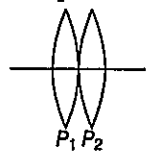If two lenses of +5 dioptres are mounted at some distance apart, the equivalent power will always be negative if the distance is
Greater than 40cm
Equal to 40cm
Equal to 10cm
Less than 10cm
The correct Answer is:A
To solve the problem of finding the distance between two lenses of +5 diopters each, such that their equivalent power is negative, we can follow these steps:
1. Understand the Power of Lenses:
- The power of a lens (P) is given in diopters (D), where 1 D = 1/meter. In this case, both lenses have a power of +5 D.
2. Formula for Equivalent Power:
- When two lenses are placed at a distance D apart, the formula for the equivalent power Peq is:
Peq=P1+P2−D⋅P1⋅P2f1⋅f2
- For our case, since both lenses have the same power, we can simplify it to:
Peq=P+P−D⋅P2
- Here, P1=P2=5 D.
3. Substituting Values:
- Substitute P1 and P2 into the equation:
Peq=5+5−D⋅(5⋅5)
- This simplifies to:
Peq=10−25D
4. Setting the Condition for Negative Power:
- We want the equivalent power to be negative:
10−25D<0
5. Solving the Inequality:
- Rearranging the inequality gives:
10<25D
- Dividing both sides by 25:
D>1025
- Simplifying gives:
D>0.4 metersorD>40 centimeters
Conclusion:
The distance D between the two lenses must be greater than 40 centimeters for the equivalent power to be negative.
---
- The power of a lens (P) is given in diopters (D), where 1 D = 1/meter. In this case, both lenses have a power of +5 D.
- When two lenses are placed at a distance D apart, the formula for the equivalent power Peq is:
Peq=P1+P2−D⋅P1⋅P2f1⋅f2
- For our case, since both lenses have the same power, we can simplify it to:
Peq=P+P−D⋅P2
- Here, P1=P2=5 D.
- Substitute P1 and P2 into the equation:
Peq=5+5−D⋅(5⋅5)
- This simplifies to:
Peq=10−25D
- We want the equivalent power to be negative:
10−25D<0
- Rearranging the inequality gives:
10<25D
- Dividing both sides by 25:
D>1025
- Simplifying gives:
D>0.4 metersorD>40 centimeters
The distance D between the two lenses must be greater than 40 centimeters for the equivalent power to be negative.
Topper's Solved these Questions
- GEOMETRICAL OPTICSBOOK - A2ZCHAPTER - GEOMETRICAL OPTICSEXERCISE - Prism Theory And Dispersion Of Light
45 Videos
- GEOMETRICAL OPTICSBOOK - A2ZCHAPTER - GEOMETRICAL OPTICSEXERCISE - Optical Instruments
55 Videos
- GEOMETRICAL OPTICSBOOK - A2ZCHAPTER - GEOMETRICAL OPTICSEXERCISE - Section D - Chapter End Test
30 Videos
- ELECTROMAGNETIC WAVES AND COMMUNICATION SYSTEM BOOK - A2ZCHAPTER - ELECTROMAGNETIC WAVES AND COMMUNICATION SYSTEM EXERCISE - Section D - Chapter End Test
30 Videos
- MAGNETISM AND MATTERBOOK - A2ZCHAPTER - MAGNETISM AND MATTEREXERCISE - Section D - Chapter End Test
30 Videos
Similar Questions
Knowledge Check
Two lenses of power +12 D and -2 D are combined together. What is their equivalent focal length ?
A8.33 cmB10 cmC14 cmD12.5 cmTwo convex lenses of focal length f1 and f2 are mounted coaxially separated by a distance. If the power of the combination is zero, the distance between the lenses is
A|f1−f2|Bf1+f2Cf1f2|f1−f2|Df1f2f1−f2Charge Q is divided into two parts which are then kept some distance apart . The force between them will be maximum if the two parts are
AQ2 and Q2BQ2 and 3Q4CQ2 and 2Q3De and (Q−e)
Two parallel lines are everywhere the same distance apart.
View SolutionTwo like poles of strengths m1 and m2 are at far distance apart. The energy repuired to bring them r0 distance apart is
View SolutionTwo thin convex lenses of focal length 20 cm and 25 cm are placed at a finite distance apart. The power of the combination is 8 D. Distance between the lenses is
View SolutionIf lenses shown have powers P1 and P2 then the combination shown,has an equivalent power

View SolutionTwo point charges Q and −3Q are placed at some distance apart. If the electric field at the location of Q is E then at the locality of −3Q, it is
View Solution
